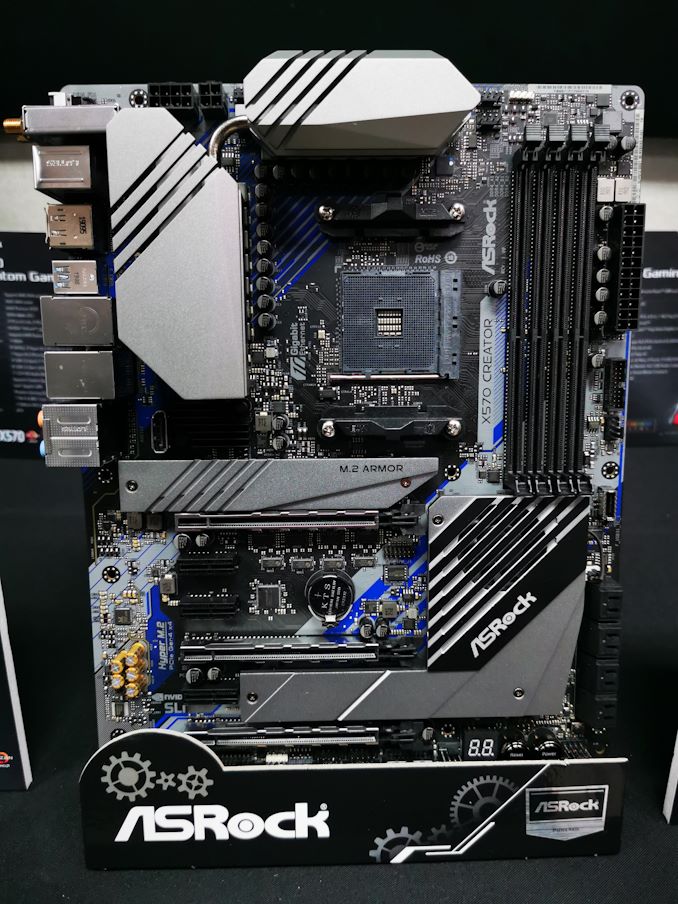The AMD X570 Motherboard Overview: Over 35+ Motherboards Analyzed
by Gavin Bonshor on July 9, 2019 8:00 AM ESTASRock X570 Creator
The ASRock X570 Creator is geared towards content creators with a similar feature set to the flagship ASRock X570 Aqua, but without the focus on high-end aesthetics, and water cooling. The X570 Creator has a simplistic and elegant theme with silver heatsinks, with black contrast.
Its X570 heatsink is actively cooled, and incorporates an M.2 heatsink, with a standalone heatsink for the top slot; the top M.2 slot supports PCIe 4.0 x4 and SATA, while the bottom slot is geared for just PCIe 4.0 x4 drives. For SATA there are a total of eight ports. On the PCIe front, there are three full-length PCIe 4.0 slots which run at x16/x8/x8, and x8/x8/x4, as well as three PCIe 4.0 x1 slots.
For memory, the ASRock X570 Creator has four slots with support for up to DDR4-4666 which remains to be seen if it will be effective or not in terms of performance. The X570 Creator also sports a 14-phase power delivery which is consistent with ASRock's other high-end offerings and has 8-pin plus 4-pin i12 V ATX CPU power inputs for delivering power to the processor. The feature set of the ASRock X570 Creator is similar to its other premium X570 models, but the main difference is primarily in the aesthetic. A cleaner, more professional look, without as much flash and pizazz. This mode has two PCIe 4.0 x4 M.2 slots, with a total of eight SATA ports with support for RAID 0, 1, and 10 arrays. A debug LED is located just below the X570 chipset heatsink, and next to these is an onboard power and reset switch.
With the ASRock X570 Creator being one of its more higher-end models, it has two rear panel Thunderbolt 3 Type-C ports. with an Aquantia AQC107 10 G LAN port, an Intel Gigabit port, Intel's AX200 802.11ax Wi-Fi 6 interface, and two USB 3.1 G2 Type-A, as well as four rear-panel USB 3.1 G1 Type-A. It also has two DisplayPorts with an input, and output, as well as one HDMI video output.
The ASRock X570 Creator comes in with an MSRP of $500 which for a premium feature set and everything on offer, it's not a bad price. There are other boards which cost slightly less with similar feature sets, but the Aquantia AQC107 10 G NIC, support for NVIDIA two-way SLI, and dual Thunderbolt 3 Type-C ports on the rear panel all add cost to the board.












225 Comments
View All Comments
abufrejoval - Tuesday, July 9, 2019 - link
It's amazing how quickly you run out of PCIe lanes, when you don't have switches to multiplex and translate between PCIe revisions and lanes (e.g. PCIe v4 x2 <-> PCIe v2 x8).I find myself using USB 3.x NBase-T NICs and NVMe adapters, simply because they *do* switch.
Bensam123 - Tuesday, July 9, 2019 - link
Maybe a bit more depth on the power delivery page. I have absolutely no idea how to go about parsing what's there. More chokes is better? What denotes a power phase?A5 - Tuesday, July 9, 2019 - link
+1. Some analysis of that information would be helpful.MrSpadge - Tuesday, July 9, 2019 - link
+1bunkle - Wednesday, July 10, 2019 - link
The controller column includes the total number of phases supported split between CPU cores and SoC e.g. (6+1) = 6 CPU phase and 1 SoC phase. More is *usually* better but has diminishing returns regarding tighter and tighter voltage regulation. Some controllers are better than others (can operate at high frequency e.g. 500KHz v 1000KHz, include other features to improve performance) mitigating the need for more phases.Each phase is a buck converter comprised of a low/high side MOSFET (can be integrated in a single package) and choke. Some controllers can support doubling up the PWM signal to driver more MOSFETs. Doublers can also be added as discrete components if not built into the controller.
Current rating of the MOSFET (e.g. Sic639=40A IR3555=60A) indicates the total power deliverable. MOSFETs are not 100% efficient and vary in efficiency. The more current they provide the hotter they get and the less efficient they become, with better MOSFETs producing less heat for a given current. Thus using doubles can improve temperatures and efficiency without the benefits of the tighter voltage tolerance that *real* phases provide.
Hope that’s helpful!
bunkle - Wednesday, July 10, 2019 - link
A lot more detailed explanation: https://en.wikichip.org/wiki/voltage_regulator_mod...bug77 - Tuesday, July 9, 2019 - link
The description for AsRock X570(M) Pro4 says "5 jack + 1 SPDIF". Unfortunately, those boards lack SPDIF and only come with 3 jacks ;)Smell This - Tuesday, July 9, 2019 - link
I'm thinking the *ASRock Thunderbolt AIC* ...https://thunderbolttechnology.net/product/asrock-t...
would cover all your TBT peripheral needs, including optical.
DanNeely - Tuesday, July 9, 2019 - link
Do X570 boards still need an extra chip per USB port to support USB-C reversibility?The additional expense and needed PCB space were cited as among the reasons why earlier generation boards (IIRC both Intel and AMD) almost never had more than 1 C port; but it was never clear to me if that was an inherent implementation penalty for the C port or an artifact of Intel's tech stack being stalled out and AMD outsourcing to ASMedia which built the chipsets on an ancient (55nm) platform.
DigitalFreak - Tuesday, July 9, 2019 - link
Gavin - X370 and X470 only supported PCIe 2.0. The connection between the CPU and chipset was 3.0, but all the ports on the chipset were 2.0.